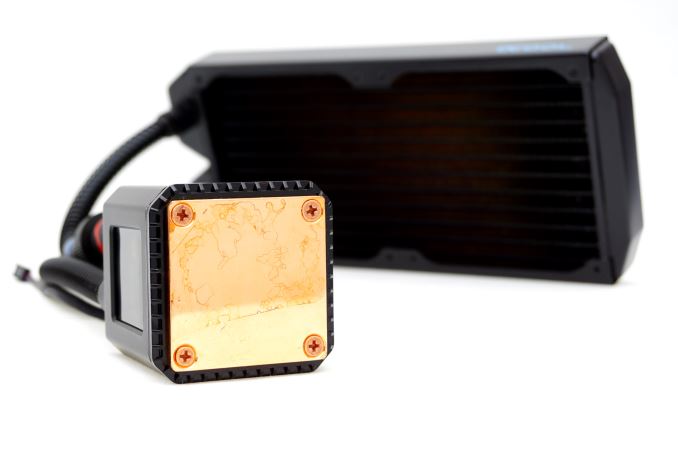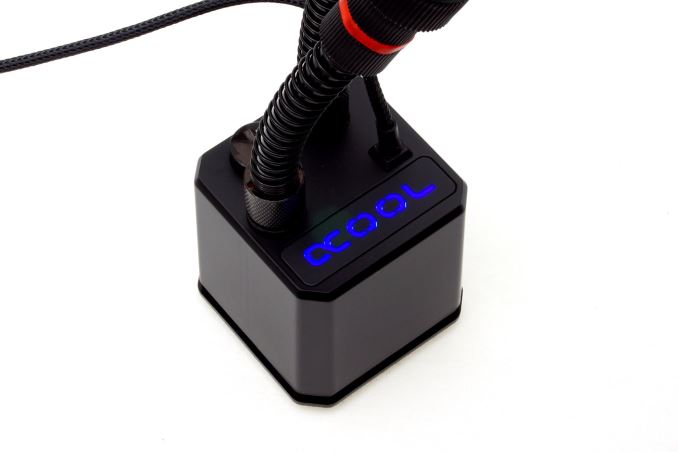The Alphacool Eisbaer 240 CPU AIO Liquid Cooler Review
by E. Fylladitakis on August 1, 2016 9:00 AM EST- Posted in
- Cases/Cooling/PSUs
- AIO
- Water Cooling
- Cooler
- Alphacool
Conclusion
In this review we had a look at Alphacool’s latest product and first AIO liquid cooler, the Eisbaer, which the company is marketing as an “extremely quiet, expandable solution”. It is true that the supplied 120 mm “Eiswind” fans did perform very well and that the ceramic pump is practically noiseless, making the Eisbaer 240 the least noisy AIO liquid cooler that we have tested to this date. Our only concern lies with the long term reliability of the fans, as while sleeve bearing engines are amongst the least noisy options, they lack the long-term reliability of other solutions that are noisier or expensive.
While the Eisbaer 240 did not outperform every other similar cooler in terms of raw thermal performance, it possibly has the best noise/performance ratio of every dual 120 mm fan AIO cooler available today. It could likely outperform several of its competitors if stronger fans were to be used, but we feel that Alphacool’s choice of fans in terms of noise performance hits the mark. Users can fall into two categories - thermal or acoustic performance, and a user that places acoustic comfort above a slim difference in thermal performance will do well here. Even with its quiet fans, the thermal performance of the Eisbaer is very good and more than adequate for the typical gamer/enthusiast that simply wants a cool and quiet high performance system.
The expandability of the Eisbaer 240 is one of the primary focus points of Alphacool’s marketing team. It is true that the Eisbaer 240 is very versatile, offering expansion options depending on the user’s skill and needs. It has a quick release connector on the tubing for users that want to keep things simple and expand using parts that the company supplies specifically for the Eisbaer, plus the company has simple tube compression fittings installed on every part that allow the user to completely remove the tubing if necessary. The Alphacool Eisbaer 240 practically is a standard, divisible liquid cooling kit that is being supplied preassembled and prefilled by the company.
Expanding the Eisbaer may be a relatively simple process but the user has to take into account the impact that the expansion will have on the performance of the system. For example, the insertion of a GPU block will add both resistance and thermal energy into the system, respectively reducing the flow of the pump and increasing the load of the radiator. A second radiator will offer quicker thermal energy dissipation but significantly burdens the pump. In theory, a single loop can be expanded to cover multiple GPU blocks and more than one radiator but, as the pump cannot be upgraded, we advise against the installation of more than three items per system. It is technically possible to add an external pump into the system but that would beat the purpose of having an AIO solution in the first place, as a customized kit would perform better and cost less at this point. Alphacool has informed us that they are currently designing a similar AIO liquid cooler for GPUs, the GPX-Pro. When the GPX-Pro becomes available, the interconnection between the two system will be possible, allowing them to share their radiators and double the pressure (but not the flow) of the pumps. Whether having the two systems interconnected will perform better than keeping them separated is a complicated discussion that depends on many specific details, such as the CPU/GPU, the position of the radiators, the strength of each pump, the usage of the system, etc., preventing us from being able to provide a simple and definite answer.
Alphacool currently retails the Eisbaer 240 in Europe for €115 incl. VAT plus shipping costs. Slightly lower pricing may be found via some of their local resellers. In the US, the Eisbaer 240 is available for $120 plus shipping. The price is higher than that of most similar competitive products, but reasonably so for a product that offers an expandable setup with a copper radiator and high thermal performance combined with near-silent operation. We highly recommend it to those seeking a low noise AIO cooling solution, especially when there is a significant preference for potential future expansions/upgrades.












69 Comments
View All Comments
Sushisamurai - Sunday, August 7, 2016 - link
I think mainstream computers/CPU's don't need liquid, at all. If you're running an enthusiast build/HEDT then I think it's almost necessary. My CPU draws almost 230W at full load - I didn't bother putting an air cooler for noise issues.rhysiam - Monday, August 1, 2016 - link
"I personally think that air coolers have reached their EOL. There is no need for a big chunk of metal to sit on top of your motherboard especially when nowadays you can buy an excellent AIO that is reasonably priced, quiet, cools better, and looks aesthetically more pleasing, and its painless to install"I can't agree with you at all on this. If we consider the three key metrics we can quantify being price, noise and thermal performance; air coolers objectively beat AIO water coolers by a significant margin. Entry level water coolers like the H60 are more expensive, hotter and louder than a wide range of air coolers, and perform terribly compared to similarly priced air towers (H60 prices take you into mid-range air cooler territory). Once you move up a tier to high end air coolers like the NH-D15, you need to spend far more money to get a similarly performing AIO. There are 240mm closed loop water coolers that appear to offer superior thermals for close to the $100 mark, but they do so by using hair-dryer like fans. If you want D15 performance from water and care at all about noise levels, you need to be prepared to spend a lot of money.
There are absolutely benefits to AIO water coolers: stress-free portability, RAM compatibility and potential to use in smaller cases. But, if you care primarily about getting the highest performing and quietest CPU cooler for your dollar, air still wins every time.
Hxx - Tuesday, August 2, 2016 - link
I bought an H55 for $25, an H110 for $55, and H100i gtx for $75, a thermaltake water 2.0 performer for $20, a thermaltake 240mm water 2.0 for about $50...over the past 4 or so years. Yes not everyday prices, but newegg sales, microcenter open boxes, etc. Like I said, no need for an air cooler anymore. Corsair even goes as far as covering your components if your cooler for whatever reason breaks and takes some other components with it.The latest cooler I bought is the corsair h100i gtx for $75. My overclocked core i7 4770k 4.6ghz sits at 25C and 40ish when gaming in a corsair air 240 case. The pump is in "quiet mode". I can't hear the fans or the pump so I m happy. Also $75 is not a lot of money for a CPU cooler when a high end air cooler is almost just as much.
ikjadoon - Tuesday, August 2, 2016 - link
Wrong. You need to update to Gen5 Asetek.http://www.hardocp.com/article/2016/02/11/arctic_c...
$25 cheaper than the NH-D15, quieter than the NH-U14S, and 5C cooler than the NH-U14S.
Keep up with reviews, dude.
rhysiam - Wednesday, August 3, 2016 - link
So this Eteknix review paints quite a different picture of that cooler you linked: http://www.eteknix.com/arctic-liquid-freezer-120-a...A full 14 degrees hotter than the D15 on an OC'd CPU (3570K) at 1.35V. Acoustics are still great, but temps, while fine, are hardly world beating. In fact they suggest 1.35V on an i5 is asking a bit too much of this 120mm cooler.
My issue with the HardOCP review is that the biggest load they put that cooler under is a 4.4Ghz OC on a 4770K at a measly 1.25V. That's just not enough to push any half decent cooler. Obviously it's got a great price and is really quiet, so would be a good choice for lots of people looking for a mild OC, but if all you want is a 1.25V mild OC, another valid option would be a cheap air cooler for $25?
I'm not saying AIO coolers don't have a place, clearly they do. But to say they make air coolers "EOL" is just not accurate IMHO.
Also, maybe ditch the BM next time? I expect better from comments here at Anandtech.
letmepicyou - Monday, August 1, 2016 - link
What you're missing about water cooling might be the fact that water cooling setups are WAY more convenient than some of the better air solutions out there. I can show you a nook in my one cupboard where I have some of the best air coolers around (Tuniq Tower, Antec CNPS 10X, Thermalright Silver Arrow, the list goes on). The problem with air? First is the weight it puts on the motherboard (which is a particular concern if you move your computer regularly). Second is the fact many high-end air coolers interfere with the ram slots, depending on the cooler / motherboard combo you happen to be using, and whether or not your ram happens to have taller than average heat sinks.The perfect solution? An AIW water cooling setup. There is no motherboard stress worth mentioning, and I have GOBS of clearance for literally any ram I choose to use, regardless of where or how it's oriented on the board. I have a pretty stout system (i7 4790k, stock clocks) but it's not always about overclocking ability or raw cooling potential, sometimes it's about pure logistics.
rhysiam - Tuesday, August 2, 2016 - link
While water may be more convenient, it's also more expensive for a similar performance tier. And it's not like low profile RAM is hard to find or has any real drawbacks. Air certainly puts more weight on the motherboard, but it doesn't introduce liquid to the system. So while water is likely safer for a portable system, I'd suggest air is the safer bet for a static PC.Clearly you'd prefer to spend more or sacrifice cooling performance for system portability and RAM compatibility... that's fine, there's heaps of situations where that's the right call. But there's undoubtedly a place on the market for the superior performance per dollar that air coolers offer.
retrospooty - Tuesday, August 2, 2016 - link
" Second is the fact many high-end air coolers interfere with the ram slots, depending on the cooler / motherboard combo you happen to be using"- You may have a point if you are upgrading an older system and therefore stuck with particular existing parts, but if you are building a new system you can build a better cooled system for cheaper with a good air cooler.
zodiacfml - Tuesday, August 2, 2016 - link
That gave me an idea for a future build. I guess, water cooling should be focusing on graphics these days.ikjadoon - Tuesday, August 2, 2016 - link
Yup. I'm slapping this AIO CLC on my next GPU: cheaper than NH-U14S, cooler than a NH-U14S, and quieter than a NH-U14S--all at the same time! :DThe reign of air coolers is about to end with Gen5 Asetek.
http://www.hardocp.com/article/2016/02/11/arctic_c...